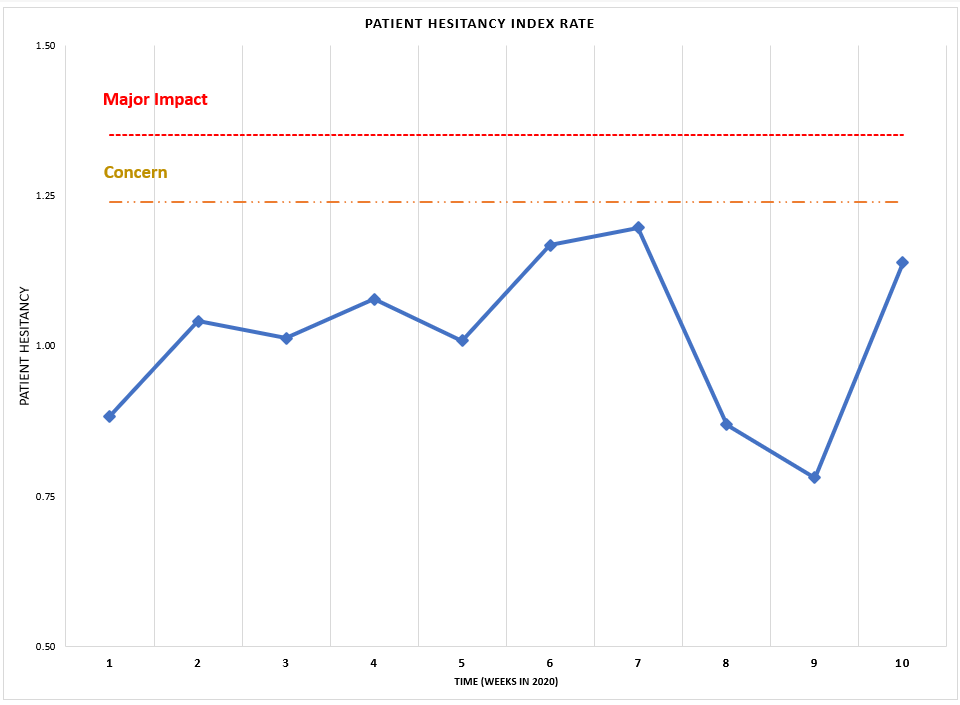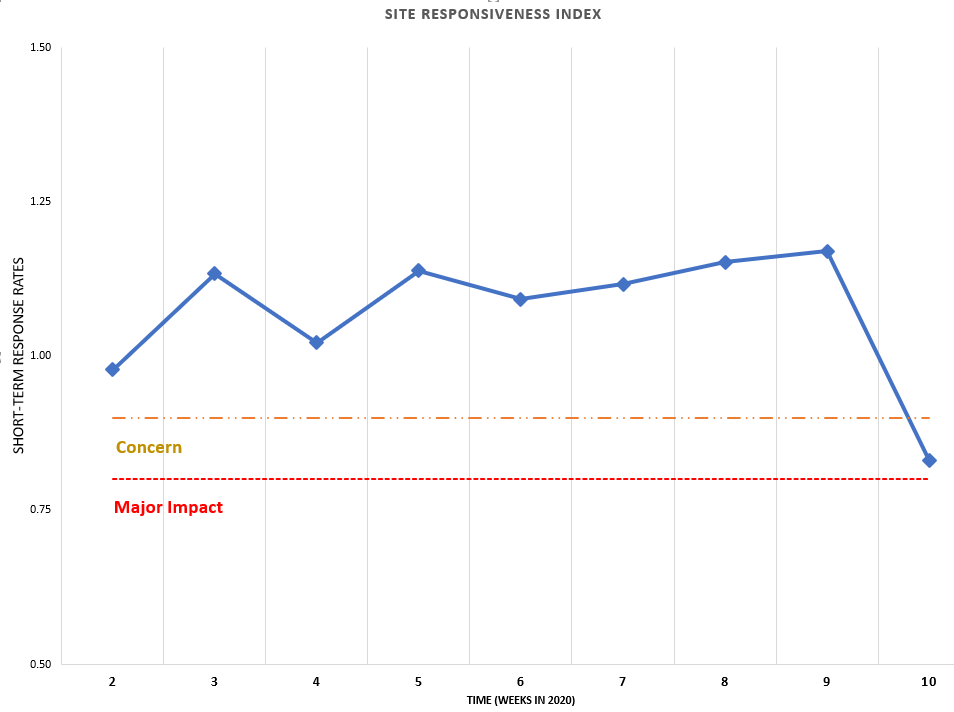Measuring the Impact of the COVID-19 Outbreak on Clinical Trials
The impact of the COVID-19 pandemic has raised several critical questions about the short- and medium-term implications for trial sites and sponsors.
Standard enrollment metrics won’t be enough to understand and react to this “once-in-a-generation” outbreak.
The impact of the COVID-19 pandemic is already being felt in hospital emergency rooms and ICUs around the globe. Within clinical research, uncertainties about the pharmaceutical supply chain, reallocation of medical resources, and potential restrictions on patient travel have raised critical questions about the short- and medium-term implications for trial sites and sponsors:
- Will increased patient hesitancy negatively impact trial enrollment rates?
- Will enrolled patients be less likely to attend study visits?
- Will site staff experience reduced capacity for conducting trials?
As we began to parse the voluminous real-time enrollment data available to us in our ContinuVue Reporting Platform, our trial recruitment tracking platform, it quickly became apparent that many of the usual enrollment metrics would not reflect the unique nature of the current outbreak. Accordingly, we set out to systematically identify and collect the relevant data points to help us understand the trajectory and model the impact of the current outbreak. Our COVID-19 dashboard synthesizes three key sources:
- Real-time measures of patient engagement: Tracking changes to patients’ behavior when learning about trials online, we have identified 3 key decision points that measure patient willingness to consider visiting a research center for screening.
- Measures of site capacity: Three key metrics pertaining to site prescreening and appointment scheduling give us rapid insight into any changes in site behavior.
- Site sentiment: We fielded a quantitative survey of representative US sites to collect direct feedback on current operations and future planning.
The results of this analysis, detailed below, indicates we have passed a probable inflection point in the outbreak that will have broad, significant impacts on clinical trial enrollment that require an immediate and fact-based response.
Changes to patient engagement
Patient hesitancy in the midst of the COVID-19 outbreak is most apparent when patients are provided the opportunity to connect with and visit a local research site for more information about the trial. We indexed patients’ refusal to consider a new site against pre-outbreak baseline rates for each trial, permitting us to measure changes across multiple trials (see figure 1).

Results and outlook: In the early weeks of the outbreak, patient hesitancy decreased. We believe this is potentially a result of an increase in health information-seeking behaviors as pandemic information became more prevalent. Last week, however, reversed that trend, and we noted a significant increase in patient hesitancy. We believe patient sentiment may be a significant driver of enrollment rate changes and we continue to monitor this data closely.
Changes to site behaviors
Continuum tracks site capacity through the velocity and volume of sites’ outreach efforts to new referrals along with their rates of scheduling screening appointments. We find their short-term response metrics to be most indicative of their focus on trial enrollment against other competing priorities (see figure 2).

Results and outlook: In the first two months of 2020, sites exhibited extremely consistent performance in reaching out to potential trial participants. However, the week of March 9 saw a major drop in responsiveness-well below levels of any time this year. While a single week cannot definitively indicate a trend, we believe site responsiveness to potentially be the single largest driver of short-term impact on enrollment performance.
Site feedback
To supplement the above measurements, we deployed a survey to a representative sample of 170 US sites from March 12 to 13. The key finding from this survey is that although many sites are attempting to remain on track for “business as usual”, a clear subset are already experiencing or anticipating recruitment and retention issues.
- For patient recruitment, a full 39% of sites believe that patients will be less willing to consent to participate in a new clinical trial, with over a third of those sites stating that patients will be “much less willing” to enroll.
- For retention in existing trials, 25% of sites anticipate patients will find it difficult to maintain their visit schedules due to COVID-19-related issues.
- Overall, 29% of sites anticipated COVID-19 as having a “big” or “extremely big” negative impact on clinical trial recruitment and retention.
These results were consistent across site types: academic sites, medical centers, and private research sites reported equivalent levels of concern about recruitment and retention. Results did vary considerably by therapeutic area, with sites conducting trials in older or more vulnerable populations-including cardiology, rheumatology, and ophthalmology-having nearly double the number of sites that anticipate significant recruitment and retention challenges.
Summary and next steps
We believe our indices demonstrate that the week of March 9 represents a probable inflection point in patient and site behaviors in regard to clinical trials. We are currently working closely with our trial sponsors to model the impact and develop planning scenarios based on our projections of immediate impact of the pandemic. To help quantify the trajectory of patient and site change, this week we intend to:
- Continue to refine and monitor these indices of patient hesitancy and site responsiveness
- Field a follow-up US survey to assess changes in attitudes
- Field an EU-focused survey to parallel the US version
As former FDA Secretary Scott Gottlieb noted just yesterday, the COVID-19 outbreak represents a “once in a generation” event, leaving us with few to no historical comparisons to understand its impact. We believe the most appropriate response for the clinical trial industry is to identify and track measures that are sensitive enough to reflect the rapidly-changing impact on trial recruitment and retention, and to build fact-based scenario plans to prepare sites and reassure patients that we are able and ready to support clinical research during these unpredictable months ahead.
Results of the survey, as well as real-time updates as new site responses come in, are available on the Continuum COVID-19 dashboard.
Paul Ivsin is the Vice President of Data & Analytics at Continuum Clinical
Improving Relationships and Diversifying the Site Selection Process
April 17th 2025In this episode of the Applied Clinical Trials Podcast, Liz Beatty, co-founder and chief strategy officer, Inato, discusses a number of topics around site engagement including community-based sites, the role of technology in improving site/sponsor relationships, how increased operational costs are impacting the industry, and more.
Behind the Buzz: Why Clinical Research Leaders Flock to SCOPE Summit
February 7th 2025In this episode, we meet with Micah Lieberman, Executive Conference Director for SCOPE Summit (Summit for Clinical Ops Executives) at Cambridge Innovation Institute. We will dive deep into the critical role of collaboration within the clinical research ecosystem. How do we bring together diverse stakeholders—sponsors, CROs, clinical trial tech innovators, suppliers, patients, sites, advocacy organizations, investors, and non-profits—to share best practices in trial design, program planning, innovation, and clinical operations? We’ll explore why it’s vital for thought leaders to step beyond their own organizations and learn from others, exchanging ideas that drive advancements in clinical research. Additionally, we’ll discuss the pivotal role of scientific conferences like SCOPE Summit in fostering these essential connections and collaborations, helping shape the future of clinical trials. Join us as we uncover how collective wisdom and cross-industry partnerships are transforming the landscape of clinical research.